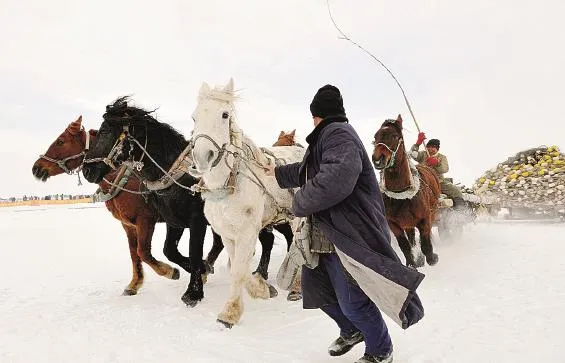冰雪奇缘
2016-05-17WangYuanchang,WangYuanchang,SunFuxing等
冰雪奇缘

While Princess Elsa in the fi lm Frozen bemoaned her magical powers where everything she touched turned to ice, people living in the highlands of Northeastern China cheer for winters that bring with them a fantastic world of ice and snow.Let's delve into a wonderful world of rime, snow, and crystalline castles that's been visiting for over a millennium.
就在《冰雪奇缘》中的艾莎公主为她点物成冰的魔法痛苦时,中国高纬度地区的东北人家,却为姗姗来迟的晶莹魔幻冰雪世界而欢呼雀跃。他们整理好行装,走进茫茫『凇都』、皑皑『雪乡』、水晶『城堡』,
开启一段穿越千年的奇遇之旅。

A shepherd walking on Jilin Rime Island.吉林雾凇岛上的赶羊人。
A Painting of Skaters from Qing Dynasty
In March 2015, a few months before Beijing and Zhangjiakou successfully secured hosting rights for the 2022 Winter Olympics, Bingxitu (a painting of skaters) was displayed at the Bird's Nest National Stadium located at the Olympic Green.The painting was produced by the court painters Zhang Weibang and Yao Wenhan during the reign of the Qing Emperor Qianlong (1736 - 1795).Bingxitu depicts skaters performing various fi gure skating maneuvers such as Daxiezi (big scorpion), Jinji Duli (the cockerel on one leg), Nezha Naohai (Prince Nezha rampages through the seas), Shuangfeiyan (two fl ying swallows), and Qianjinzhui (thousand pound fall) as well as tricks such as pole climbing, pole vaulting, and the wielding of tridents, blades, staves, and banners, and even engaging in military drills and archery.Members of the International Olympic Committee expressed their amazement at the historical work of art that clearly revealed skating to be an age-old sport that has always been practiced in China.

The painting of Bingxitu during the Qianlong period of the Qing Dynasty, is now collected in the Imperial Palace.珍藏于故宫的清乾隆时期的巨幅画卷《冰嬉图》。
Ice and snow have been an integral part of Chinese history since ancient times.The lengthy northern winters, cold climates, and abundance of water helped give rise to a rich and extensive landscape that allowed winter cultures to fl ourish.During the Sui and Tang dynasties, the Jurchen tribes who lived in the Baishan Heishui (White Mountains and Black Rivers) invented the Zhuma (literally translated as “the bamboo horse”) that allowed them to traverse frozen ice surfaces with ease.This was the earliest form of a skating tool in China.When the northern people became the new overlords of China, they also introduced ice sports to China's heartland.A national tradition during the reign of Emperor Qianlong was to host a Bingxi Shenghui (a grand festival of ice sports) that starts from Dongzhi (winter solstice) and ends at Sanjiu (the 27th day after the winter solstice).
Bingxi is an ancient Chinese phrase for ice sport.The Qing Dynasty is considered as the Golden Age of fi gure skating in ancient China, thanks to the martial prowess and courageous character of the Manchu warriors, the geographical features of their native homelands, as well as their folk traditions.Emperor Taizu of the Qing Dynasty, Nurhaci, was a master skater and organized a military unit that was completely equipped with Wula Huazi (skating shoes) in his campaign to unite the Jurchen tribes.

Snowy Sun Island in Harbin.哈尔滨太阳岛雪景。

Horse-drawn carts with people for a winter fishing on the icy Chagan Lake.吉林查干湖冰面上,拉着大网的马车和准备去冬捕的人们。
This special unit traversed over 700 li (350 km) within 24 hours bearing guns and cannons on sleds.After establishing the Later Jin, Nurhaci repeatedly held a sports competition on ice at Hun River in Shenyang with his peers, princes, of fi cers, wives, and concubines.The competition included dozens of events like paobing (skating race), huabingche (sled racing), chou bingga (spinning ice top), da huada (a form of ski jumping), and xuedizou (walking on snow).Acrobatic maneuvers, dances, and even football and other games were brought to the ice rink as well.A large feast was then held on the ice.Cattle and goats were slaughtered and prepared for a sumptuous banquet, allowing all participants to eat and drink their fi ll.
Partying on Ice
Bingxi was not limited to the extravagant Imperial festivals on ice.The people in northeastern China still enjoy having fun with snow and ice each year.The temperature drops below freezing point after a night of harsh northern wind, and fl owing rivers and lapping lakes are turned into shimmering and smooth ice rinks.Once the ice becomes thick enough, everyone – regardless of age – will rush onto the ice surface.In addition to natural and large ice rinks at HeilongJiang River, Songhua River, Ussuri River, Hun River, and Jingyue Pool, improvised ice rinks located in parks of various cities and professional ice rinks and skiing resorts with advanced equipment and amenities are also popular among many people.
Visitors standing at the levees can see how the winter converts the roaring currents of Songhua River into an epic and shimmering layer of ice.Iceboats skim along the frozen surfaces of meandering rivers, while numerous ice parks and rinks populate the regions near the riverbank.The most popular attractions are the 200-meter long ice slides and snow rubber ring parks.Adults and children alike sit on in fl atable rubber rings and fl y down the slides to enjoy the rush and excitement provided by the speed of the ride.
Holes cut on the ice surface are popular places for winter swimmers to take a dip in.As they emerge from these ice holes in their swimsuits, steam swirls around their bodies.People also partake in snow fi ghts, building snowmen, riding ice sleds, and playing ice hockey and curling.The sounds of laughter and joy are also accompanied by the cracking of whips in spinning top competitions.Despite being outdoors, such games inspire a passion that help people cope with the sub-freezing temperatures.
白山黑水冰嬉图
2015年3月,在北京携手张家口赢得2022年冬奥会举办权之前,奥林匹克中心鸟巢体育场里,一幅乾隆年间宫廷画家张为邦和姚文翰绘制的《冰嬉图》引起关注。大蝎子、金鸡独立、哪吒闹海、双飞燕、千斤坠等样式的花样滑冰和爬竿、翻杠子、飞叉、耍刀、使棒、弄幡等样式的杂技滑冰,以及练兵的溜冰射箭等等场景,引发了国际奥委会评估团成员对中国冰雪运动的悠久历史的惊赞。
中国冰雪文化源远流长,北方漫长的冬季、寒冷的气候、丰富的水资源,为冰雪文化的形成提供了广泛而充足的载体。早在隋唐时期,生活在“白山黑水”地区的女真族便发明了滑冰的竹马,成为中国人最早的滑冰方式。随着北方民族入主中原,一些冰上运动也被带入内地。清乾隆帝在位时期,将每年“冬至”到“三九”期间举行的“冰嬉盛会”定为国俗。
冰嬉,是中国古代对冰上运动的统称。清代之所以能成为中国古代花样滑冰的“黄金时代”,与满人英勇彪悍的民族性格和所处的地域环境、民族风俗等息息相关。“滑冰高手”清太祖努尔哈赤,在统一女真各部的战争中,组织了一支“皆着乌喇滑子”的滑冰部队,这支特种部队完全靠滑冰前进,一天一夜行军700多里,火炮也架在冰爬犁上运送。建立“后金”政权后,努尔哈赤曾多次率领诸王、贝勒等官员及其妻妾,在沈阳浑河举行“冰上运动会”。跑冰、滑冰车、抽冰嘎、打滑挞、雪地走等数10余种比赛,不一而足,甚至将杂技、舞蹈、蹴鞠等文体项目挪到了冰面上。还在冰上举行盛大宴会,杀牛宰羊,直至尽兴。
江河湖泊上的冰雪欢歌
传承数百年的冰嬉,不仅是古时皇家华丽的“冰上盛宴”,也是如今东北地区百姓休闲娱乐的重要方式。当寒风呼啸的一夜过后,气温骤降到冰点,往日波光粼粼的江、河、湖面瞬时光滑如镜。冰面刚刚结实,男女老少们就按捺不住了,成群结队涌上冰面,迫不及待地上演一场场轰轰烈烈的冰上狂欢。除了黑龙江、松花江、乌苏里江、浑河、净月潭等天然“大冰场”外,各城市内的公园“野冰场”和设施先进的专业滑冰、滑雪场,也备受人们青睐。
站在江堤向松花江北岸望去,夏日里奔腾的江水,已凝结成一首壮美的史诗。远处蜿蜒的江面上点点冰帆点缀其中,近处是数个大大小小的冰上游乐场。近200米长的冰滑梯和雪圈乐园无疑是最受欢迎的地方。无论大人小孩子都可以坐在橡胶雪圈上,从大滑梯上奋力而下,享受“飞”的感觉。
凿出的一片冰窟窿是冬泳爱好者们的地盘。刚从水里出来穿着泳衣的冬泳人,身体周围冒着雾气,站在雪中与游客们合着影。远处大片的空地上,打雪仗、堆雪人、滑冰车、赛冰球、掷冰壶的欢笑声和着抽冰尜的清脆鞭子声,飘荡在澄空净宇之上。虽然身处室外,运动燃起的激情,却似乎令人忘却了冰点下的严寒。
FASCINATING FROZEN WORLD
Text by Wang Yuanchang Photos by Wang Yuanchang, Sun Fuxing & VCG Translation by Sonia

1.People enjoy flying on the snow with rubber rings.在橡胶雪圈上享受“飞”的感觉。


3.Kids playing on the ice.在冰面上玩耍的小朋友。
